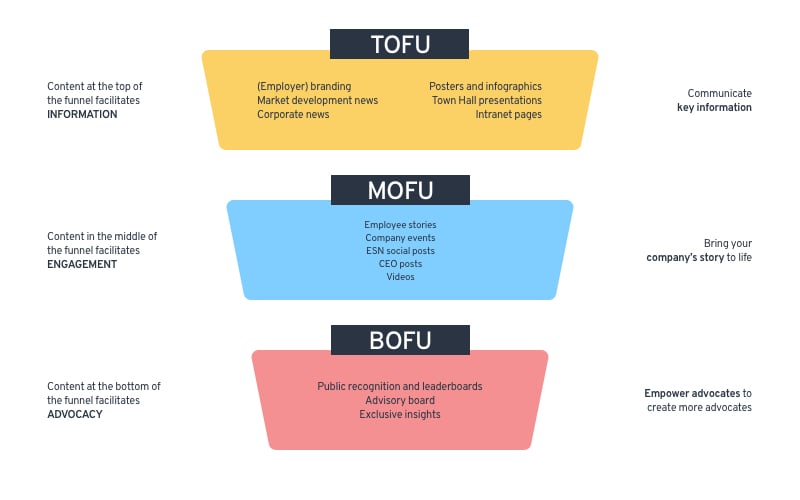

Internal Communications
6 steps to master your new Internal Communications role
11 mins read
Fri, Apr 30, '21
Teams & Organizations

Internal Communications

Jonathan Davies
11 mins read
Fri, Apr 30, '21
Congratulations! If you’re reading this post you probably just started a new Internal Comms role at a new company. Or maybe you switched roles, and now you’re doing Internal Comms.
Regardless, you have a bit of a road ahead. You need to reach the minotaur in the middle of your organizational labyrinth. The good news? These days, we have Google Maps :) To help you on your way, here are the 6 things that will get you to kick butt in your new role. Enjoy!
Internal Communication focuses on sharing information with employees inside an organization. Good Internal Communication empowers and engages employees by:
Yet, there are still organizations out there that still neglect the importance of Internal Comms, but poor Internal Communications can also be a silent killer:
Internal Communication managers work with all departments to ensure that employees stay up-to-date with all company news, goals, projects, and plans. Here are some of the most common tasks for Internal Comms teams:
Internal Communication channels can be emails, internal blogs, intranet platforms and slide decks. Managing these channels includes creating, scheduling and posting content, reviewing and reporting on engagement metrics, maintaining editorial calendars, researching and developing stories, shooting videos, and contributing. Now that’s what you call a handful.
Internal Communication teams help crafting and communicating messages and programs through internal events, speaker selection and logistics.
This task can include analysing existing tools and channels, researching prospective tools and vendors, collaborating with IT and the C-Suite and purchasing new technology.
Mike Klein, principal at Changing the Terms says “the first thing you’ll want to do is talk to a dozen or so people. The rest will follow naturally”. So let’s start there.
Organizations can’t engage or create alignment from the top-down, without understanding what’s happening from the bottom-up. Find out what people across ages, departments - and if possible, locations - are saying about the organization. What do they love? What do they want to change? What do they know a lot about and what company knowledge do they find lacking? How well do teams or departments communicate with each other? This, and more, will help you gain an impression of what the organization’s actual internal identity is.
Bonus points if you want to supplement this with a quantitative research method such as surveys, but do prepare this in advance. Sending a questionnaire across (a large part of) an organization will probably require some stakeholder approval.
The information you gather from employees serves as fuel for questions to leadership. Yes, it may all start with a mission, vision and core values, but different departments will be aligned with this in different ways. Leaders are still the most trusted source of communication to employees, so understanding what they communicate is key to understanding where your challenge really lies.
When you’ve found the patterns between what employees are saying and what the organization is saying it needs from Internal Comms, then can you start forming objectives. Yes, they need to adhere to the bog-standard SMART definition, we won’t bore you with that explanation. We do want to emphasize that measurable objectives are your friend, not your enemy. They help you show progress, but more importantly, they also help you prioritize. Get sign-off from leadership on those objectives, and you gain a strong tool to prioritize your work with. You’ll have a much easier time saying “No” the next time Johnny from Sales wants you to proofread his internal presentation.
"With personas, less is more.” Dan Williams, UX Design Lead at Enreach starts. “Be sure to sample multiple diverse people from different "departments" ... and then forget about their job and department. Instead, focus on their core working styles. You’re not looking to define a vertical job role, but gain insights into the horizontal measures that bind or differentiate a group. These can be hard or soft, quantitative or qualitative, in written form or visual – all to enrich the context of use and ultimately empathize with your users. The last thing you want is a persona-per-department.”
Williams’ point around personas is something that needs to be heard. It’s crucial to form a templated understanding of your target audience, but don’t over-do it. “Employees” may not be a target group, but there is a healthy balance between too much and not enough. Read this article for the basics of what a persona profile should include. Then add the 6 things Dan says are essential to a good persona profile:
It’s a bit too much to list here, but let’s just say there’s an easier way to organize which messages you’re sending, across which channels, and for which specific goals that you set in point 3. Fill out the funnel below and you should be well on your way!

For more information on using this, read our post on The Internal Content Funnel.
A while ago we spoke with Advita Patel, chair of the CIPR Inside committee, about the essentials of Internal Communications. She had a gem of a point of understanding the business. Patel says:
“Having business acumen as an Internal Communications specialist will put you leaps and bounds ahead of any other communicator out there because you can talk the language and add value. That’s a skill some IC people don’t really consider they need, but if you’re writing comms you need to understand what the business is about.”
Leadership aren’t just stakeholders in your activities. They’re also an important channel for Internal Communications. We referenced Gatehouse’s State of the Sector report before, and it shows that employees still consider their direct leader as the most credible source of information in a company. In North-America, high-level leadership visibility is valued the most. In Europe it’s line-management.
We already spoke of “leadership” in point 1, but don’t forget line managers with that. Getting them on your side has been a battle that Internal Comms has been waging for years, but when you’re fresh, new and a blank slate, you may be able to gain the upper hand early.
At Happeo, we hope to make your working environment more productive than ever. Book a personalized demo and speak with one of our team members about enterprise intranet solutions today.

